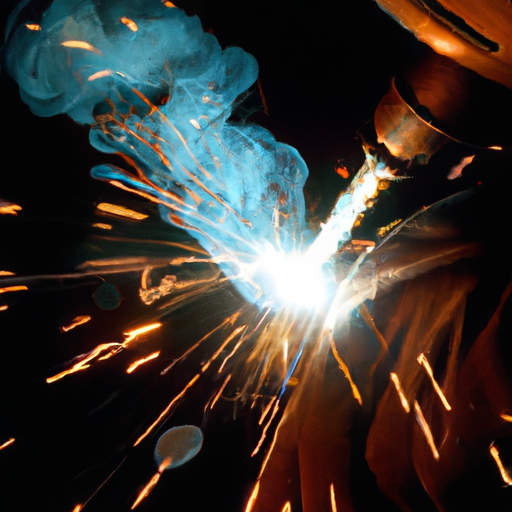Hey there! Did you know that you can actually learn MIG welding right in the comfort of your own home? That’s right! MIG welding, short for Metal Inert Gas welding, is a popular technique used in various industries. If you’ve always been curious about trying your hand at this skill or want to enhance your existing welding abilities, then keep reading. In this article, we’ll explore the possibilities of learning MIG welding from the comfort and convenience of your own home, providing you with some helpful insights and tips along the way. So, grab your welding helmet, because it’s time to ignite your welding passion!
Understanding MIG Welding
What is MIG Welding?
MIG welding, also known as Metal Inert Gas welding, is a popular welding process that involves feeding a solid wire electrode through a welding gun, which melts and fuses the base metals together. This process is widely used in various industries, including automotive, construction, and manufacturing, due to its versatility and ease of use.
Origin and History of MIG Welding
MIG welding was developed in the 1940s as a result of the efforts to find an efficient way to join aluminum for aircraft production during World War II. It was initially referred to as Gas Metal Arc Welding (GMAW) and gained popularity for its ability to rapidly produce strong welds. Over the years, advancements in technology and equipment have made MIG welding accessible not only to industrial professionals but also to DIY enthusiasts and hobbyists.
How Does MIG Welding Work?
MIG welding works by creating an electrical circuit between the welding gun and the metal being welded. A continuous wire electrode is fed through the gun and melted by an electric arc, which also generates the heat needed to fuse the metals. In addition, a shielding gas, typically a mixture of argon and carbon dioxide, is used to protect the weld from atmospheric contamination. This gas creates a stable arc and prevents oxidation and porosity in the weld.
Advantages and Disadvantages of MIG Welding
MIG welding offers several advantages that make it a preferred choice for both professionals and DIYers. Firstly, it is a relatively fast welding process that allows for high productivity. Additionally, MIG welding offers excellent control over the weld, resulting in clean and precise welds. Moreover, it can be used on a wide range of materials, including carbon steel, stainless steel, and aluminum. However, MIG welding does have some limitations. It requires a constant supply of electricity, making it less suitable for remote locations. It also produces more heat and requires the use of a shielding gas, which adds to the overall cost of the process.
Safety Measures While Welding
Importance of Safety in Welding
Safety should always be the top priority when engaging in any welding activity. MIG welding, like any other welding process, involves potential hazards such as electric shock, arc radiation, and exposure to harmful fumes and gases. By following proper safety measures, you can significantly reduce the risks and ensure a safe working environment.
Safety Equipment Needed for Welding
To stay safe while MIG welding, it is essential to have the right safety equipment. This includes a welding helmet with a full face shield to protect your eyes and face from arc radiation. Additionally, welding gloves and flame-resistant clothing are necessary to protect your hands and body from sparks and heat. Moreover, wearing welding boots and a welding apron can provide additional protection against falling objects and hot debris. Lastly, it is crucial to have a fire extinguisher nearby and a well-stocked first aid kit in case of accidents.
How to Safely Handle Welding Equipment
Proper handling and maintenance of welding equipment are essential to prevent accidents and ensure your safety. When handling welding equipment, always make sure to wear proper protective gear and follow the manufacturer’s instructions. Before starting any welding task, inspect the equipment for damage, and ensure that all cables and hoses are in good condition. It is also important to secure the workpiece to prevent any movement during the welding process. Most importantly, never leave welding equipment unattended, and always turn off the power source when not in use.
Dealing with Potential Welding Hazards
MIG welding involves a few hazards that need to be addressed to maintain a safe working environment. One major concern is the exposure to welding fumes and gases, which can be harmful to your health. To avoid this, it is essential to work in a well-ventilated area or use local exhaust ventilation systems to remove the fumes. If necessary, using respiratory protection, such as a powered air-purifying respirator, is recommended. Another potential hazard is the risk of electrical shock, which can be minimized by wearing dry gloves, using properly grounded equipment, and avoiding wet surfaces. Additionally, practicing good housekeeping by keeping the work area clean and free from clutter can prevent tripping hazards and potential accidents.

Setting Up Your Home Welding Space
Choosing the Right Space for Welding
When setting up your home welding space, it is important to choose an area that is well-suited for welding activities. Ideally, you should have a separate dedicated space such as a garage or workshop that provides ample room for your welding equipment and materials. The area should be well-ventilated to ensure proper air circulation and reduce the risk of exposure to welding fumes. Additionally, consider the availability of electrical outlets and ensure that the space allows for easy movement and access to your welding equipment.
Essential Equipment for Your Welding Space
To set up your home welding space, you will need a few essential pieces of equipment. Firstly, you will need a welding table or workbench that provides a stable and secure surface for your welding projects. It should be made of non-combustible material, such as steel, to prevent any fire hazards. Additionally, having a welding cart or storage system is beneficial for organizing and storing your welding equipment and accessories. Another crucial piece of equipment is a fire-resistant welding curtain or welding screen, which helps contain sparks and protect the surrounding area from potential damage.
Maintaining Proper Ventilation
Proper ventilation is crucial in a welding space to ensure your safety and the quality of your welds. Welding fumes contain hazardous substances such as manganese, chromium, and nickel, which can be harmful if inhaled. To maintain good ventilation, it is recommended to work in an area with natural ventilation, such as open doors or windows. Alternatively, installing a ventilation system, such as exhaust fans or downdraft tables, can effectively remove welding fumes and provide clean air to breathe. Regularly check and clean ventilation systems to ensure optimal performance.
Organizing and Keeping Your Workspace Clean
Keeping your welding workspace clean and organized is essential for efficient and safe welding. By having a clutter-free work area, you can minimize the risk of accidents and maintain better focus during your welding projects. Invest in storage solutions, such as shelves or cabinets, to keep your welding tools and accessories organized and easily accessible. It is also important to regularly clean your welding equipment, removing any debris or spatter, to ensure optimal performance. Additionally, proper disposal of welding waste, such as metal shavings or used electrodes, should be followed to maintain a safe and clean workspace.
Acquiring MIG Welding Equipment
Types of MIG Welders
When acquiring MIG welding equipment, it is important to understand the different types of MIG welders available in the market. The two main types are transformer-based MIG welders and inverter-based MIG welders. Transformer-based welders are known for their reliability and durability, and they are suitable for heavy-duty applications. Inverter-based welders, on the other hand, are more lightweight and portable, making them ideal for DIY projects or welding in different locations.
Determining the Right MIG Welder for Home Use
Choosing the right MIG welder for home use depends on various factors, such as the thickness of the materials you will be welding, your skill level, and your budget. For light to medium welding tasks, a welder with a lower amperage range should suffice. However, if you plan on working with thicker materials or need higher welding speeds, a welder with a higher amperage range is recommended. It is also important to consider additional features such as adjustable wire speed and voltage control, as these can provide more flexibility and control over your welding projects.
Setting Up Your MIG Welder
Setting up your MIG welder properly is crucial for achieving optimal weld quality. Start by reading the manufacturer’s instructions carefully and familiarizing yourself with the specific features and settings of your welder. Make sure that the power supply is adequate for the welder’s requirements and properly grounded. Select the appropriate type and size of welding wire for your project and install it correctly in the welder. Additionally, adjust the wire speed and voltage settings based on the material thickness and welding technique. Before starting any welding, perform a test weld to ensure that the settings are adjusted correctly.
Maintenance of MIG Welding Equipment
Proper maintenance of your MIG welding equipment can prolong its lifespan and ensure consistent performance. Regularly inspect your welder for any damage or signs of wear, such as frayed cables or loose connections. Clean the welding gun regularly, removing any built-up spatter or debris that may affect the weld quality. It is also important to regularly clean or replace the contact tip and the nozzle to prevent any blockages. Additionally, check the gas regulator and hoses for leaks and replace them if necessary. Following the manufacturer’s maintenance guidelines and scheduling regular service checks can help identify and address any potential issues before they affect your welding process.

Learning Basic Welding Techniques
Different Types of Welding Joints
understanding different types of welding joints is essential to produce structurally sound and aesthetically pleasing welds. Some common types of welding joints include butt joints, lap joints, T-joints, and corner joints. Each joint requires a specific welding technique and preparation to ensure proper fusion and strength. By familiarizing yourself with these joints and practicing the corresponding welding techniques, you can improve the quality and integrity of your welds.
Understand MIG Welder Settings
To achieve optimal weld results, it is crucial to understand and adjust the settings of your MIG welder correctly. The primary settings to consider are wire speed and voltage. Wire speed controls the rate at which the electrode is fed, while voltage determines the heat input to the weld. The optimal settings for your weld will depend on factors such as the material thickness and type, welding position, and desired weld bead size. Experimenting with different settings and practicing on scrap pieces of metal can help you find the best settings for various welding applications.
Practicing Different Welding Positions
Welding can be performed in various positions, including the flat position, horizontal position, vertical position, and overhead position. Each position requires specific techniques and adjustments to maintain proper penetration and control over the weld pool. By practicing welding in different positions, you can enhance your skills and broaden your capabilities as a welder. Start with simpler joints and gradually progress to more challenging positions to build your confidence and proficiency.
Mastering Welding Speed and Technique
The speed at which you move the welding gun along the joint, known as travel speed, significantly affects the quality of the weld. Moving too fast can result in a weak and underpenetrated weld, while moving too slow can cause excessive heat buildup and distortion. Finding the right balance between travel speed and heat input is crucial. Additionally, mastering the technique of maintaining a consistent arc length, controlling the weld pool, and manipulating the gun smoothly can greatly enhance the overall quality of your welds. Regular practice and seeking feedback from experienced welders can help you refine your welding speed and technique.
Accessing Welding Education Online
Importance of Online Welding Education
Online welding education has become increasingly popular as a convenient and flexible way to learn and improve welding skills. It offers the opportunity to access a wealth of resources and educational materials from the comfort of your own home. Online welding education allows you to learn at your own pace, focusing on specific areas of interest or skill development. It also provides access to virtual welding simulations, interactive quizzes, and instructional videos, enhancing the learning experience.
Best Online Platforms for Welding Education
When it comes to online platforms for welding education, several reputable options are available. Some popular choices include professional welding associations, industry-leading welding equipment manufacturers, and dedicated welding education websites. These platforms offer a wide range of courses and tutorials, catering to different skill levels and areas of interest. It is important to do your research and choose a platform that suits your specific needs and learning style.
Self-taught vs Online Welding Courses
Whether to pursue a self-taught approach or enroll in structured online welding courses depends on your learning preferences and goals. Self-taught welding involves learning through books, online resources, and trial and error. It can be beneficial for individuals who prefer a more independent learning style and have the patience to experiment and practice extensively. On the other hand, online welding courses provide a structured curriculum, expert guidance, and interactive learning experiences. These courses offer a more accelerated learning path and can be beneficial for individuals seeking professional certification or a career in welding.
Recognized Online Welding Certification Programs
If you wish to obtain a recognized welding certification, several online programs offer accredited certification courses. These programs follow industry standards and provide comprehensive training in welding techniques, safety procedures, and relevant codes and standards. Some well-known certifications include those offered by the American Welding Society (AWS) and the Welding Certification Bureau (WCB). These certifications can enhance your employability and open doors to various career opportunities in the welding industry.

Practicing MIG Welding at Home
Starting with Simple Projects
When starting to practice MIG welding at home, it is important to begin with simple projects that allow you to develop your skills and confidence. Choose projects that involve basic welding joints and utilize materials that are readily available and affordable, such as mild steel or scrap metal. Examples of simple projects include making garden trellises, small decorative items, or welding repairs on broken household items. As you gain more experience and proficiency, you can gradually progress to more complex projects that challenge your skills.
Guidelines for Regular Practice
Consistent practice is key to mastering MIG welding. Set aside regular time slots for practice sessions, even if it’s just a few hours a week. During your practice sessions, focus on specific skills or techniques that you want to improve. Consider setting specific goals for each practice session, such as achieving consistent bead appearance or mastering a particular welding position. As you practice, take note of your progress and seek feedback from experienced welders to identify areas for improvement and ways to enhance your skills.
Avoiding Common Mistakes
As a beginner in MIG welding, it is common to make mistakes. However, being aware of common mistakes can help you avoid them and improve your welding outcomes. Some common mistakes include using improper settings, moving too fast or too slow, insufficient cleaning of the metal surface, and lack of proper joint preparation. Take the time to understand the fundamentals of MIG welding and pay attention to details such as proper weld bead size, penetration, and minimizing heat distortion. By practicing good technique and developing a critical eye for your welds, you can minimize mistakes and produce high-quality welds.
Building a Portfolio of Welding Projects
Building a portfolio of your welding projects serves multiple purposes. Firstly, it allows you to showcase your skills and progress as a welder. A portfolio can be a valuable asset when applying for welding jobs, seeking career opportunities, or establishing your reputation as a skilled welder in your community. Additionally, maintaining a portfolio helps you track your growth and development over time, serving as a visual record of your achievements. Include both simple and complex projects in your portfolio to demonstrate your versatility and range of skills.
Dealing with Welding Troubleshooting
Common Welding Problems
Welding can sometimes present challenges, and being aware of common welding problems can help you troubleshoot and overcome them. Some common welding problems include incomplete fusion, porosity, cracking, and spatter. These issues can occur due to improper preparation, incorrect settings, or insufficient technique. By understanding the causes and symptoms of these problems, you can take appropriate corrective measures and improve your welding results.
Understanding Welding Defects and Distortions
Welding defects and distortions can occur during the welding process and can affect the quality and integrity of the weld. Common defects include undercutting, lack of fusion, and excessive penetration. Distortions can result in the warping or deformation of the welded joint. Understanding the causes and remedies for these issues is crucial to produce strong and visually appealing welds. Techniques such as preheating, controlling heat input, and using proper joint preparation can help minimize defects and distortions.
MIG Welder Troubleshooting Tips
When troubleshooting issues with your MIG welder, there are a few common tips that can help identify and resolve the problem. First, check the power source and ensure that it is properly connected and delivering the correct voltage. Inspect the welding gun, cables, and connectors for any damage or loose connections. Make sure that the welding wire is feeding smoothly and that the contact tip and nozzle are clean and in good condition. Additionally, ensure that the shielding gas is flowing properly and check for any leaks in the gas supply system. If the issue persists, consult the manufacturer’s troubleshooting guide or seek assistance from a qualified professional.
Regular Maintenance and Inspection for Avoiding Issues
To minimize welding issues and ensure consistent performance, it is important to regularly maintain and inspect your welding equipment. Inspect the welder for any signs of wear, loose connections, or damage, and address any issues promptly. Clean the welding gun and replace any worn or damaged components, such as the contact tip, nozzle, or diffuser. Regularly clean or replace the welding wire spool to prevent any feeding problems. Additionally, check the gas regulator and hoses for leaks or damage, and replace them if necessary. By incorporating regular maintenance and inspection into your welding routine, you can avoid potential issues and prolong the life of your welding equipment.

Joining a Welding Community
Benefits of Joining a Welding Community
Joining a welding community can bring numerous benefits and opportunities for personal and professional growth. Being part of a community of like-minded individuals allows you to connect with fellow welders, share experiences, and learn from each other. By participating in discussions and forums, you can gain valuable insights, exchange tips and tricks, and discover new welding techniques and equipment. Additionally, a welding community can provide networking opportunities, job leads, and access to industry events, further enhancing your career prospects in the welding industry.
Finding Local and Online Welding Communities
Finding local welding communities can be as simple as reaching out to local welding associations or trade schools in your area. They often host workshops, training programs, and networking events where you can meet and connect with other welders. Online welding forums, social media groups, and specialized websites dedicated to welding are also excellent places to find and connect with the welding community. These platforms allow you to interact with welders from all around the world, sharing experiences and knowledge without geographical limitations.
Participating and Contributing to a Welding Community
Active participation and contribution are key to getting the most out of a welding community. Engage in discussions, ask questions, and share your own experiences and expertise. By actively contributing to the community, you not only build relationships but also establish yourself as a valuable member. Consider sharing your welding projects, techniques, and tips to inspire and educate others. Helping fellow welders troubleshoot issues or providing guidance to beginners can also make a significant impact within the community.
Learning from Shared Experiences within the Community
One of the greatest advantages of being part of a welding community is the ability to learn from the shared experiences of others. There is a wealth of knowledge within the community, and hearing about real-life welding projects, challenges, and innovative solutions can broaden your understanding and perspective. Engage in conversations, ask for advice, and take advantage of the diverse experiences and expertise of the community members. By actively listening and learning from others, you can continuously improve your skills and stay updated with the latest trends and techniques in the welding industry.
Exploring Career Opportunities in Welding
Scope of a Career in Welding
A career in welding offers a wide range of opportunities and pathways for individuals with the right skills and passion. Welders are in demand across various industries, including manufacturing, construction, automotive, and aerospace. Skilled welders can pursue careers as welding technicians, fabricators, pipefitters, or even welding inspectors. Moreover, with further training and experience, welders can advance to positions such as welding supervisors, instructors, or quality control specialists. The scope for career growth and specialization in welding is vast, making it an attractive field for those seeking long-term career prospects.
Welding Certification and its Benefits
Obtaining a welding certification can greatly enhance your career prospects and open doors to better job opportunities. Certification programs, such as those offered by professional bodies like the American Welding Society (AWS), validate your skills and knowledge in specific welding processes and techniques. Welding certifications are recognized globally and provide proof of your competence and expertise to potential employers. Having a certification demonstrates your commitment to the profession and can give you a competitive edge in the job market.
Job Profiles in the Welding Industry
The welding industry offers a diverse range of job profiles to suit different interests and skill sets. Some common job profiles in the welding industry include welding technician, welder fabricator, pipe welder, sheet metal worker, and welding inspector. Welding technicians are responsible for operating and maintaining welding equipment, while welder fabricators specialize in assembling and welding metal components. Pipe welders focus on welding pipes and fittings, and sheet metal workers fabricate and install metal products. Welding inspectors ensure that welds meet quality standards and adhere to established codes and specifications.
Continuing Education for Career Growth in Welding
Continuing education is crucial for career growth in the welding industry. As technology advances and new techniques emerge, staying updated with the latest trends and practices is essential to remain competitive. Consider enrolling in advanced welding courses or specialized certifications to expand your skill set and knowledge. Additionally, attending industry conferences, workshops, and trade shows can provide opportunities to network with experts and gain insights into emerging technologies and career pathways. By actively pursuing continuous learning, you can advance your career and unlock new opportunities in the welding industry.
In conclusion, MIG welding is a versatile and widely used welding process that can be learned and practiced at home. Understanding the basics of MIG welding, following proper safety measures, and setting up a dedicated welding space are essential for successful welding projects. Acquiring the right equipment, mastering basic welding techniques, and accessing online welding education can help improve your skills and expand your knowledge. Regular practice, troubleshooting welding issues, and joining a welding community contribute to personal and professional growth in the welding industry. With the right training, certification, and continued education, a rewarding career in welding awaits those who have a passion for this craft.

